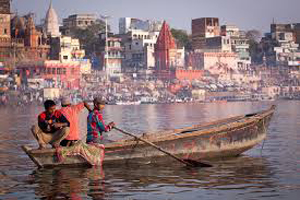Ganga cleaning improves aquatic life
Mangalore Today News Network
Haridwar, Oct 23, 2014, (IANS): The Ganga cleanliness drive is helping improve the river’s aquatic life.Researchers who studied the condition of the river before and after the latest mass cleanliness drive say there have been visible positive results. The study covered Har Ki Pauri, one of the most popular and crowded ghats of the largest river basin in the world. Researchers from Dev Sanskriti Vishwavidyalaya and Gurkul Kangri Vishwavidyalaya say the campaign helped temperature to dip to 18.1 degrees Celsius from 19 degrees
Researchers from Dev Sanskriti Vishwavidyalaya and Gurkul Kangri Vishwavidyalaya say the campaign helped temperature to dip to 18.1 degrees Celsius from 19 degrees
The turbidity levels, however, plunged in a major way. At the same time, the transparency level of the Ganges increased by almost 1.5 times -- from 18 cm to 30 cm.
Interestingly, the chloride level decreased significantly from 26 mg/l to 16 mg/l and the TDS (total dissolved solids) came down to 102 mg/l from as high as 210 mg/l.
"Temperature affects the metabolic rate in the aquatic environment. It was great to see a reasonable change in the same," said a statement issued by lead researchers Sushill Bhadula and B.D. Joshi.
Bhadula is a professor of environmental science at the Dev Sanskriti Vishwavidyalaya. Joshi is from the department of zoology and environmental science at Gurukul Kangri Vishwavidyalaya.
"Similarly, the better the transparency, the more is the penetration of sunlight in water which is good for aquatic plants," the statement said."The transparency was maximum Oct 14, the last day of the cleanliness campaign. We are happy with the results," it added.
The cleanliness and the mass awareness programme was conducted by Haridwar-based spiritual group Shantikunj as a part of its nationwide Clean Ganga drive.
"The cleanliness drive not only focussed on cleaning the river water but also made visitors and localities aware of the hazards created (by irresponsible acts)," a spokesman for Shantikunj said.
The 2,525-km-long river is not only considered holy by Hindus but is also a lifeline to millions. It flows from the Himalayas to the Bay of Bengal.But the Ganga is considered one of the most polluted rivers in the world. The pollution affects not only human life but also fish and amphibian species.
- JEE (Main) second edition results to be announced by April 19: NTA
- Three arrested for raping woman in Mangaluru, say police
- Summer rush: Special trains, Vande Bharat sleeper announced for Mangaluru
- Mangaluru: Yellow alert issued as thunderstorms expected across coastal Karnataka
- Mangaluru: Bride-to-be goes missing a day before wedding in Bolar
- Puttur: Grand Brahmarathotsav at Shri Mahalingeshwara Temple draws thousands with devotion and splendor
- Karnataka HC raps state over protest against Waqf Act amid pending SC case
- Fisheries Ministry to launch data collection across the country for Marine Fishers Census from November
- Elephant tries to sneak into house in Mudigere
- Holy Thursday celebrated with solemnity at Our Lady of Miracles Church, Milagres
- ABVP to launch ‘Save Mangalore University’ campaign
- MLA asks corporation to focus on landslip-prone areas and under-construction buildings ahead of Monsoon
- Mangaluru: Woman gang-raped near Netravati river, auto driver among three arrested
- CET row: Karnataka govt orders probe after students asked to remove sacred thread
- Man who flashed woman, assaulted 7 people arrested in Bengaluru
- FIR against Sunny Deol, Randeep Hooda for offending Christian religious sentiments in Jaat
- 22 maoists surrender before security forces in Chhattisgarh’s Sukma
- Indian Embassy repatriates 4 nationals scammed in Myanmar’s Myawaddy
- ED debunks Bengaluru man’s claims of importing Rs 50-crore wolfdog
- Special cabinet meeting on caste census in Karnataka ends without any major decision
- High Court to hear Ranya Rao bail plea on April 21
- India slams Pakistan Army chief’s remarks: ‘Kashmir’s only relation with Pak is…’
- Removal of sacred thread at CET centre in Shivamogga triggers row
- JD Vance, wife Usha to visit India from April 21-24, hold talks with PM Modi
- 22 Naxalites arrested, explosives seized in Chhattisgarh
- Skills and Competencies Take Center Stage at MSN Dialogue Series
- Court remands Maoist Lakshmi to six-day police custody
- Sandhya Shenoy honored with Society for Materials Chemistry Medal-2024
- White Cornus Apartment in Mangaluru
- City girl wins first place in state-level spell bee competition
- Alleged ‘Love Jihad’ Case in Mangaluru: Woman left home voluntarily, says police
- Girl fatally struck by reckless two-wheeler near Belman
- New residential complex for the judges inaugurated in Mangaluru
- Absconding accused nabbed after 8 years
- Truck with cylinders turns turtle in Beltangady
- Bhoota Kola artist dies of cardiac arrest
- Development of the country should be our goal: Ganesh Karnik
- Container truck gets stuck under Modankap railway bridge
- Truck crushes bike’s pillion rider near BC Road
- Head constable dies of heart attack
- CITY INFORMATION
- TRAVEL
- TOURIST INFORMATION
- HEALTH CARE
- MISCELLANEOUS




 Write Comment
Write Comment E-Mail To a Friend
E-Mail To a Friend Facebook
Facebook Twitter
Twitter  Print
Print 


